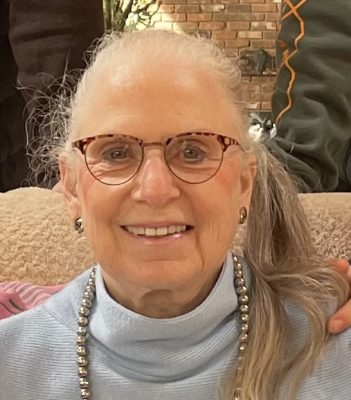A Few Fingers Could Have Saved This Armonk Resident From Months of Pain
Opinion Advocates for ideas and draws conclusions based on the author/producer’s interpretation of facts and data.

By Vivien Bonnist Cord
It was August 2019 when I visited our local pharmacy for my annual flu shot. All seemed to go well; the shot felt as expected.
But after about six hours, I realized I was unable to lift my arm. All strength had disappeared, and the pain was far greater than I anticipated. Reaching behind my back, putting my hair up, and even holding a cup of coffee quickly became impossible.
What had gone wrong? I Googled “intense pain after a vaccination,” and all my symptoms confirmed that I had received the needle too high—into my bursa. I learned that my injury had an acronym: SIRVA, or Shoulder Injury Related to Vaccine Administration.
I had no idea what a long road lay ahead.
The journey started with a bewildered physician assistant visit, followed by a second PA visit, where I received a cortisone shot in the back of my shoulder. Relief lasted a mere two days. My general practitioner had never heard of SIRVA, but believed me—with a willingness to learn. That willingness became my new prerequisite.
Next, I saw an orthopedic surgeon who assumed, based only on a physical exam, that I had a torn rotator cuff and needed surgery. Following protocol, an X-ray was ordered, which showed nothing. An MRI followed, which was more revealing. The radiologist—unfamiliar with SIRVA—described the results as “wear and tear.”
Still seeking a doctor who would believe me, I went to a second orthopedist. He also had not heard of SIRVA and showed no interest, but prescribed physical therapy. The physical therapist said he could cause more harm than good, so I opted out.
By now, I was a raving maniac in excruciating pain. Of note: SIRVA gets worse at night, and sleeping becomes impossible. Lack of sleep changes a person drastically. Additionally, over-the-counter pain medication does not relieve this injury. Doctors did not like me—and I didn’t like myself.
A SIRVA injury can manifest in several ways:
-
Bursitis: Inflammation of the bursa, a fluid-filled sac that cushions and reduces friction between bones, tendons, and muscles in the joint. In SIRVA, bursitis can occur if the vaccine needle punctures or irritates the bursa, leading to pain, swelling, and limited movement.
-
Frozen shoulder: Also known as adhesive capsulitis, this condition involves thickening and tightening of the capsule surrounding the shoulder joint. SIRVA can contribute through inflammation and scar tissue formation, resulting in pain and stiffness.
-
Rotator cuff injury: The rotator cuff is a group of tendons and muscles that stabilize and enable shoulder movement. SIRVA-related trauma can cause pain, weakness, and limited range of motion.
-
Shoulder tendonitis: Inflammation of the tendons, which connect muscles to bones. In SIRVA, improper vaccine placement can inflame these tendons, causing pain and difficulty moving the arm.
-
Ulnar neuropathy: Damage or compression of the ulnar nerve, which runs from the neck to the hand. While SIRVA doesn’t typically involve nerve damage, it can indirectly lead to neuropathy if swelling affects the nerve’s path, causing tingling, numbness, or weakness.
After four months of suffering and seeing three orthopedic surgeons, I met with Dr. P in Connecticut. He didn’t believe my diagnosis, but told me: “It’s time to stop looking back and start looking forward.”
It was December when he performed arthroscopic surgery. His report read:
“Synovial fluid, cloudy yellow. She has fibrinous debris within the glenohumeral joint. She has raging synovitis. She has grade 3 degenerative changes of the glenohumeral joint. She has degenerative tearing of the superior, anterior and posterior labrum. She has partial tearing of the superior subscapularis as well as partial tearing of the supraspinatus. Her entire capsule was enveloped in papillary synovitis.”
The damaged bursa was removed. It took three months, but I was finally pain-free—and grateful. No doubt he never wanted to see me again (I was awful), and I regret not having the opportunity to thank him and show him some kindness.
My mission has been to educate as many people as possible about SIRVA. The most important message: this malpractice injury is 100 percent avoidable by simply placing two, three or four fingers (depending on your size) horizontally at the top of your arm where it meets your shoulder to protect that area.
Vaccinations are meant to be given into the deltoid muscle. If you are sitting, the vaccinator should be sitting as well. That’s it—injury avoided. Bring this knowledge with you. Do not count on the vaccinator understanding the consequences of a mistake.
SIRVA happens when a needle is administered in the wrong location. It can result from any vaccination and is not related to the substance in the syringe.
Shortly after my injury, I started a Facebook group to share my experience. To date, the support group has reached 4,000 victims worldwide.
Vivien Bonnist Cord, 84, has lived in Armonk since 1989 and grew up in Larchmont. A former dance teacher and consumer show producer, she is currently selling the Donald Art Company Collection.

Examiner Media – Keeping you informed with professionally-reported local news, features, and sports coverage.
